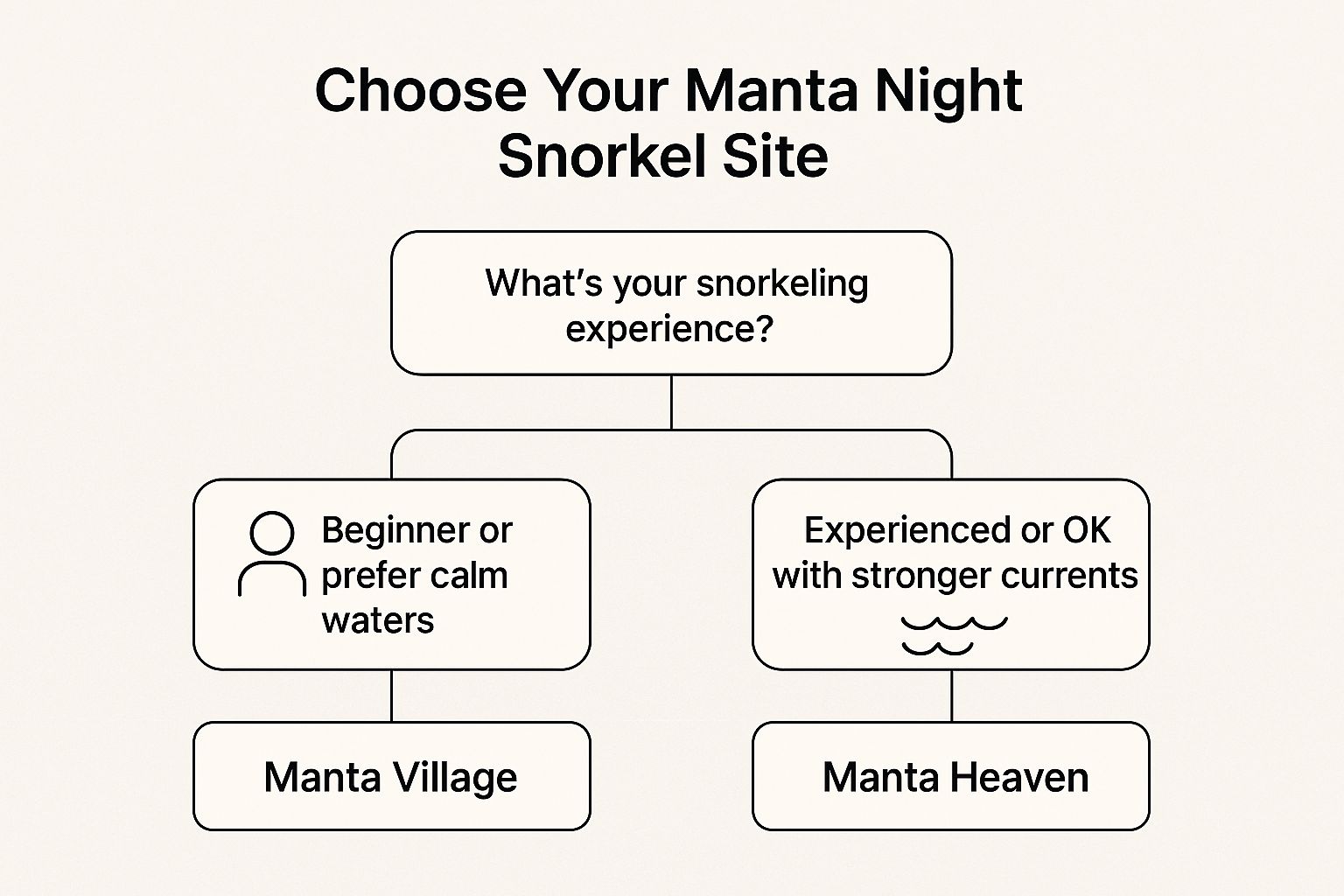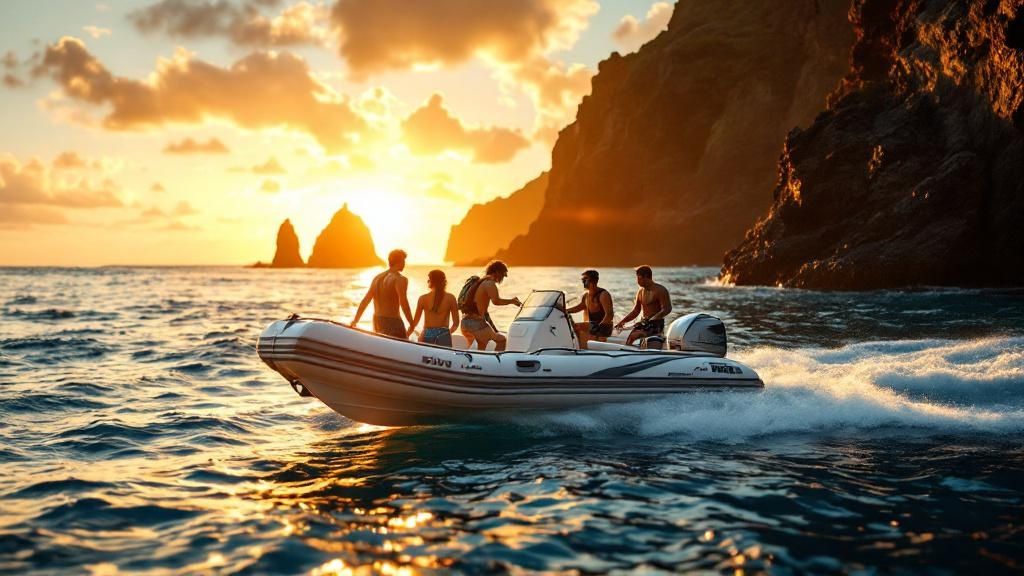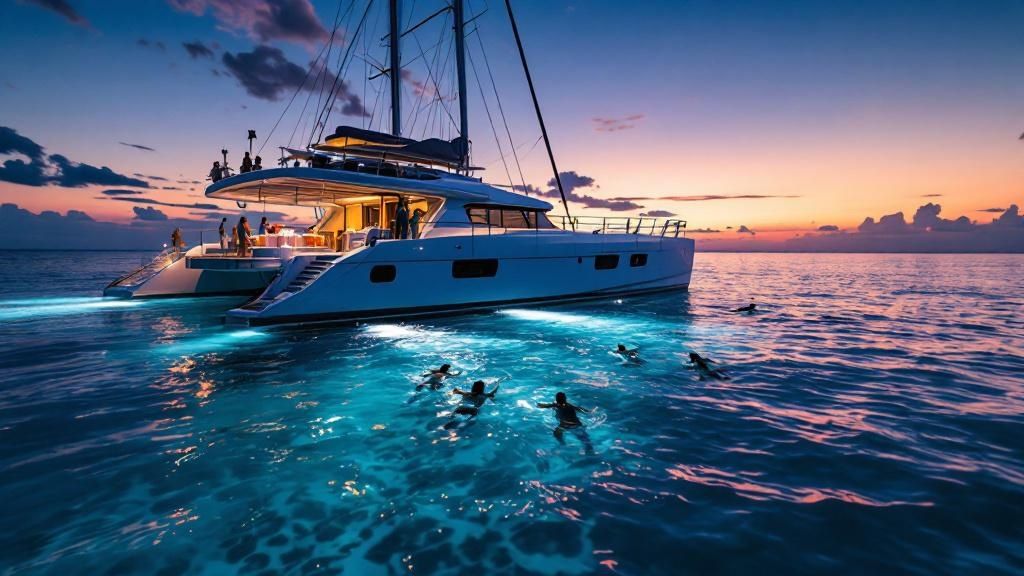Manta Ray Snorkel Big Island: Top Tips for 2025
- Byron
- Jul 1
- 10 min read
Witnessing giant manta rays glide through the ocean at night is one of Hawaii's most magical encounters. But planning the perfect manta ray snorkel on the Big Island involves more than just picking a date. It's about choosing the right tour type, understanding the locations, and knowing how to have a safe, respectful, and unforgettable experience. This guide moves beyond simple reviews, providing a curated list of six essential resources, from specific tour operators to key conservation programs.
We will break down the crucial details you need to plan your adventure from start to finish. You will learn the pros and cons, insider tips, and practical considerations for each option. By the end, you will have a clear, step-by-step framework for selecting and booking the ideal tour, ensuring you are fully prepared for this breathtaking spectacle off the Kona coast. This list is your blueprint for an incredible underwater ballet.
1. Manta Ray Night Dive at Kona Coast
The Kona Coast Manta Ray Night Dive is an internationally acclaimed wildlife encounter and a cornerstone of any manta ray snorkel Big Island itinerary. This experience allows you to get incredibly close to majestic Pacific manta rays as they feed on plankton. Operators anchor boats at one of two primary sites, Manta Village or Manta Heaven, and use powerful underwater lights to attract the plankton, which in turn draws in the mantas.
Participants, whether snorkeling or diving, hold onto a floating light board or gather near seabed lights. The mantas then perform an underwater ballet, gliding and somersaulting just inches away to scoop up their food. Some resident mantas, like the famous "Lefty," are spotted regularly, adding a personal touch to the encounter.
Choosing Your Snorkel Site
Selecting the right location is crucial for a great experience, as water conditions can vary significantly between the two main sites. Your comfort level and snorkeling ability should be the primary factors in your decision.
The following decision tree helps visualize which site is best suited for your experience level.

This flowchart simplifies the choice: Manta Village is the recommended spot for beginners due to its calmer, more protected waters, while Manta Heaven is better for experienced snorkelers who are comfortable with potential currents.
Practical Tips for Your Tour
Booking: Reserve your tour 2-3 days in advance, especially during peak tourist seasons (winter and summer).
Seasickness: The boat is anchored for a significant duration. Take motion sickness medication beforehand if you are prone to it.
In-Water Conduct: Remain calm and hold onto the light board. The mantas are attracted to the steady light source, and sudden movements can disrupt their feeding patterns.
This incredible experience is a must-do, offering a front-row seat to one of nature's most graceful spectacles.
2. Captain Zodiac Rafting Adventures
For those seeking an exhilarating journey to their manta ray snorkel Big Island encounter, Captain Zodiac Rafting Adventures offers a unique, high-speed experience. Their tours utilize rigid inflatable boats (RIBs), also known as zodiacs, which allow for a faster, more adventurous ride along the Kona Coast. This approach combines the main event of manta ray snorkeling with thrilling coastal exploration, including sea caves and historical sites not always accessible to larger vessels.
This tour is ideal for adventurers who enjoy a bit of a bumpy, fast-paced ride on the water. The smaller group sizes on these boats create a more intimate and personalized atmosphere, both during the coastal tour and in the water with the mantas. You'll often see spinner dolphins and explore remote locations like Red Hill before arriving at the manta ray site.

What to Expect on a Zodiac Tour
The zodiac experience is fundamentally different from a large catamaran tour. The ride is close to the water, faster, and more maneuverable, allowing the captain to navigate into sea caves and get closer to coastal features. You can explore a more comprehensive view of the Kona coastline, including a stop at Kealakekua Bay to view the Captain Cook Monument from the water. Learn more about the unique journey with Captain Zodiac Rafting Adventures.
Practical Tips for Your Tour
Clothing: Wear quick-dry clothing or a swimsuit. Bring a light jacket or extra layers, as the ride back after sunset can be cool.
Safety: Securely store all loose items like hats and sunglasses before the boat gets up to speed. The ride can be bumpy, so it is crucial to hold on.
Accessibility: Inform the crew of any mobility issues or back problems when booking. The zodiacs require a degree of physical agility to board and navigate.
Motion Sickness: Due to the boat's speed and movement, taking Dramamine beforehand is highly recommended if you are prone to seasickness.
3. Kona Honu Divers Manta Ray Experience
Kona Honu Divers offers a premium manta ray snorkel Big Island tour that stands out for its deep commitment to marine education and conservation. This locally-owned operator provides an experience that goes beyond simple wildlife viewing by incorporating rich, educational briefings about manta ray biology, behavior, and the importance of responsible tourism. Their partnership with research organizations ensures that your tour contributes directly to the protection of these magnificent animals.
The tour begins with a comprehensive presentation where guides, often marine biologists or conservationists, introduce you to the local manta ray population. They utilize photo-identification charts, helping you recognize specific mantas by their unique spot patterns. This educational focus enriches the in-water experience, transforming it from a simple snorkel trip into a meaningful encounter with individual, named rays.
A Focus on Conservation
Kona Honu Divers actively participates in conservation efforts, making them a top choice for eco-conscious travelers. They integrate responsible practices into every aspect of their operation.
Examples include their collaboration with the Manta Pacific Research Foundation for data collection and their regular involvement in marine debris cleanup dives. By choosing this operator, you are supporting a business that actively invests in the health of the marine ecosystem you are there to enjoy. Their dedication is a core part of the Kona Honu Divers Manta Ray Experience.
Practical Tips for Your Tour
Engage with the Briefing: Pay close attention to the pre-snorkel educational session. It provides valuable context that will enhance your appreciation of the mantas.
Camera Settings: If bringing an underwater camera, use a red filter. This minimizes disturbance to the mantas and helps produce clearer, more vibrant night photos.
Follow Guidelines: Adhere strictly to the crew's instructions. This ensures both your safety and the well-being of the manta rays, allowing them to continue their natural feeding behaviors undisturbed.
This tour is ideal for snorkelers who value learning and want their tourism dollars to support genuine conservation work.
4. Fair Wind Cruises Manta Ray Adventure
For those prioritizing comfort and stability, the Fair Wind Cruises Manta Ray Adventure offers a premier manta ray snorkel Big Island experience. Fair Wind utilizes large, custom-built catamarans that provide a very stable and spacious platform for the tour. This makes them an excellent choice for families, first-time snorkelers, or anyone concerned about potential seasickness on smaller vessels.

Operating since 1971, Fair Wind has a long-standing reputation for quality and safety, often reflected in consistently high TripAdvisor and Google ratings. Their tours are comprehensive, typically including a full dinner service, premium snorkel gear, and even a post-snorkel freshwater rinse. This all-inclusive approach simplifies the evening, allowing you to focus entirely on the incredible manta ray spectacle. The large boats also feature full facilities like restrooms, adding to the overall comfort.
Who Should Choose This Tour?
This tour is ideal for families with children, larger groups, and snorkelers who prefer a more stable, full-service experience. The spacious decks and amenities reduce the feeling of being crowded and provide a comfortable base before and after getting in the water. If you are a guest on a cruise ship, Fair Wind is also a popular and reliable operator for shore excursions.
For more details on what to expect from this tour operator, you can learn more about the Fair Wind Cruises Manta Ray Adventure.
Practical Tips for Your Tour
Arrival: Get to the dock early to secure the best seating, especially if you want a premium viewing spot for the sunset cruise to the site.
Amenities: Take full advantage of the amenities offered, such as the hot dinner and the freshwater showers, which are a welcome comfort after being in the saltwater.
Booking: Due to their popularity, especially with cruise ship passengers, booking well in advance is highly recommended.
Gear: While they provide all necessary equipment, arriving early also ensures you get a proper and comfortable gear fitting.
5. Manta Ray Advocates Research and Education
Enhancing your manta ray snorkel Big Island tour with a layer of knowledge and purpose is what Manta Ray Advocates offers. This non-profit organization focuses on the research, education, and conservation of Hawaii's resident manta ray population. Instead of being a tour operator, they provide a scientific context that transforms a beautiful wildlife encounter into a meaningful citizen science experience.
By collaborating with marine biologists and cataloging individual mantas in their extensive database, they provide invaluable data on population health and behavior. They educate the public on how to interact with these animals responsibly, ensuring the sustainability of this unique activity. Engaging with their work allows you to see the mantas not just as tourist attractions but as individuals with unique stories and personalities.
Participating as a Citizen Scientist
You can actively contribute to manta ray conservation by participating in their programs. This deepens your connection to the marine environment and adds significant value to your trip.
One of the easiest ways to get involved is through photo identification. Manta rays have unique spot patterns on their undersides, similar to a human fingerprint. By submitting clear photos of a manta's belly from your snorkel tour, you help researchers track individuals, monitor their health, and understand their movements. This simple action directly supports long-term conservation efforts.
Practical Tips for Engagement
Pre-Tour Education: Before your snorkel, visit their website or attend one of their free presentations. Learning to identify a few key mantas beforehand makes the in-water experience even more exciting.
Photo Contributions: Focus on getting clear, well-lit shots of the manta's ventral side (belly). These images are crucial for accurate identification in their database.
Advocacy: Choose tour operators who follow the Manta Ray Green List standards for responsible tourism, which Manta Ray Advocates helps promote.
This educational approach provides a richer understanding of the ecosystem you are visiting. Learn more about the research and education efforts of Manta Ray Advocates to see how your visit can make a difference.
6. Keauhou Bay and Kealakekua Bay Snorkel Sites
While the night snorkel is iconic, a daytime manta ray snorkel Big Island experience is possible at Keauhou Bay and the historic Kealakekua Bay. These protected areas are not just beautiful snorkeling spots; they serve as critical manta ray "cleaning stations." Here, mantas visit during the day to have smaller fish remove parasites from their skin, offering a different kind of encounter than the nighttime feeding frenzies.
A visit to these bays provides a holistic marine life adventure. Kealakekua Bay, where Captain Cook first landed in Hawaii, is a vibrant underwater marine sanctuary teeming with coral and tropical fish. Keauhou Bay is known for its calmer waters and reliable cleaning stations. Combining a day trip to one of these locations with a night tour offers a complete perspective on manta ray behavior.
Choosing Your Snorkel Bay
Deciding between Keauhou and Kealakekua often depends on what you want to combine with your snorkel. Both offer fantastic underwater scenery, but they have distinct characteristics.
Keauhou Bay is easily accessible and often included in tours departing from Kailua-Kona. Its main draw is the high probability of seeing mantas at their cleaning stations. Kealakekua Bay is more remote and best reached by boat tour, offering pristine reef conditions and significant historical context, making it a richer overall excursion. For those interested in this historic and vibrant location, you can learn more about Captain Cook snorkel tours in Kealakekua Bay.
Practical Tips for Your Tour
Go Early: Visit in the morning for the best visibility, calmest water conditions, and fewer crowds.
Respect the 'Aina: These are protected marine areas. Use only reef-safe sunscreen and never touch coral or harass marine life.
Guided Tours: Consider a guided tour, especially for Kealakekua Bay. Guides provide necessary historical and ecological context that enhances the experience.
Maintain Distance: If you encounter a manta ray at a cleaning station, observe from a respectful distance to avoid disturbing their natural behavior.
Top 6 Manta Ray Snorkel Experiences Compared
Tour/Experience | Core Features & Highlights | User Experience & Quality ★★★★☆ | Value & Price 💰 | Target Audience 👥 | Unique Selling Points ✨ |
|---|---|---|---|---|---|
Manta Ray Night Dive at Kona Coast | Prime sunset/night snorkeling, 2 sites (beginner & advanced), >90% manta sightings | Top-rated, close manta encounters, year-round | $95-200, premium pricing | Experienced snorkelers/divers | World-famous, high success, calm vs advanced site options 🏆 |
Captain Zodiac Rafting Adventures | Fast RIB boat, manta snorkeling + dolphin watching, sea caves | Adventurous, smaller groups, marine naturalist guides | $150-200 per 4-hr tour | Adventure seekers, thrill lovers | Remote sites access, multi-activity combo tour ✨ |
Kona Honu Divers Manta Ray Experience | Small groups (max 12), marine education & conservation focus | Educational, personalized, strong safety protocols | Higher price, limited spots | Eco-conscious, learners | Conservation emphasis, detailed briefings, local ownership ✨ |
Fair Wind Cruises Manta Ray Adventure | Large catamaran, dinner included, family-friendly amenities | Most comfortable & stable, full facilities | Higher cost, all-inclusive | Families, casual snorkelers | Spacious, dinner onboard, multiple water access points 🏆 |
Manta Ray Advocates Research & Education | Citizen science, photo-ID, workshops, conservation | Educational, research-driven, no direct tours | Free/Donation-based | Scientists, conservationists | Real research involvement, citizen science opportunities ✨ |
Keauhou & Kealakekua Bay Snorkel Sites | Protected bays, day manta & reef snorkeling, historic sites | Calmer, lower manta chances, beginner friendly | Variable, often cheaper/independent | Day snorkelers, history buffs | Daytime manta cleaning stations, cultural significance ✨ |
Making Your Manta Memories Last
Your journey to witness the majestic giants of Kona is now fully mapped out. Experiencing the manta ray snorkel Big Island tour is more than just an excursion; it's a profound connection with one of the ocean's most graceful creatures. By understanding the differences between tour operators, from the adventurous zodiacs to the larger, more stable vessels, you can select the perfect fit for your travel style and comfort level. The key is moving beyond being a simple spectator to becoming an informed and respectful participant in this incredible natural spectacle.
The most critical takeaways from this guide are practical and centered on responsible tourism. Remember to:
Book Well in Advance: The best tours, especially during peak season, fill up weeks or even months ahead.
Prioritize Safety and Sustainability: Choose Manta Ray Green Listed operators who follow strict guidelines to protect the animals and their habitat.
Respect the Wildlife: Never touch the manta rays. Your role is to be a passive observer, allowing them to carry on their natural feeding behaviors undisturbed.
Following these steps ensures not only that you have a breathtaking and memorable experience but also that you contribute positively to the conservation of this unique ecosystem. Mastering this planning process transforms a simple vacation activity into a deeply rewarding encounter. You are not just ticking a box; you are engaging with the underwater world in a meaningful way.
The silent, ethereal ballet of manta rays feeding under the lights is a memory that will stay with you long after you've dried off. It’s a powerful reminder of the beauty and fragility of our planet's marine life. By choosing your tour wisely and acting as a steward of the ocean, you help ensure that this magical experience will be available for generations of adventurers to come. Float, watch, and be amazed.
Ready to book an unforgettable, specialized adventure? For a tour focused exclusively on creating a premium and intimate manta ray snorkel Big Island experience, look no further than Manta Ray Night Snorkel Kona Hawaii Tours. Their expert guides and commitment to small group sizes ensure you get the best possible view of the underwater ballet. Book your tour with Manta Ray Night Snorkel Kona Hawaii Tours today and prepare for the memory of a lifetime.
Comments